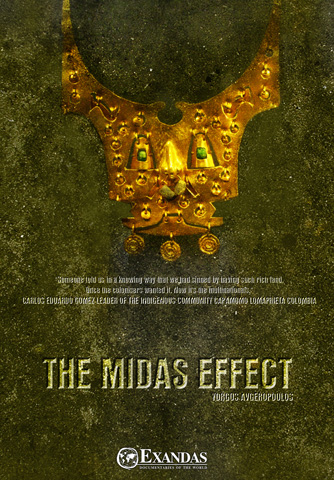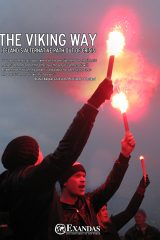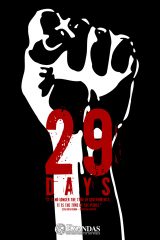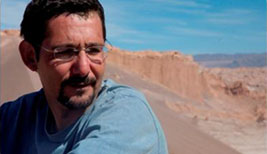
The Midas Effect
Dir: Yorgos AvgeropoulosWhen the Spanish conquistadors reached Colombia in the 16th century, they thought they had found the mythical El Dorado. In amazement, they watched a ritual at Lake Guatavita, near modern day Bogota, in which the leader of the Muiscas, naked and coated with gold dust, threw enormous amounts of gold into the water as an offering to the gods.
Five centuries later, with gold prices skyrocketing due to the global economic crisis, this time multinational companies are searching Colombia for the new El Dorado. And they are not alone. Guerrillas, paramilitaries, and drug cartels are all claiming a share of the legendary gold deposits.
Gold rush fever, along with cocaine, fuels the civil war which has been raging in the country for over 40 years. It is an invisible form of collateral damage inflicted by the economic turbulence engulfing the planet.
Watch the Film Now!
Choose the language you prefer and stream the film in Full HD from any digital device. Enjoy your private screening!
Buy the DVD
Public Screening
Are you interested in organizing a public screening of our film? Send us an email with your inquiry and we will be glad to assist you!
Educational / Library Use
Are you interested in enriching the library of your institution with our film? Contact us and let's create together an informed public!
- DURATION: 60min
- AVAILABLE IN THE FOLLOWING LANGUAGES: English | Greek
- AVAILABLE VERSIONS: English (60min) | Greek (60min)
- YEAR OF PRODUCTION: 2011
- Written, Produced and Directed by: Yorgos Avgeropoulos
- Production Manager: Anastasia Skoubri
- Director of Photography: Yiannis Avgeropoulos
- Research Coordinator: Georgia Anagnou
- Research: Manolis Fylaktidis
- Editing: Yiannis Biliris, Anna Prokou
- Original Music: Yiannis Paxevanis
PRODUCTION NOTES
Gold is the barometer of fear. In the midst of the global economic crisis, on the 22nd of August 2011, it hit a historic high of 1889.70 dollars an ounce—an almost unbelievable price, taking into consideration that 10 years ago this much gold cost only 271 dollars.
Today Colombia is one of the biggest producers of gold in South America and one of the most important gold producers in the world. In 2010, gold production reached 54 tons, however it is estimated that there are still enormous reserves which are completely unexplored.
So Colombia is in the throes of a gold rush. Everyone—from the traditional gold miners trying to make a living, to the multinationals, guerrillas, paramilitaries and drug cartels—is rushing to mine as much gold as possible, whether legally or illegally, in order to capitalise on high prices, and all are indifferent to the terrifying consequences this has for society and of course the environment.
The first symptoms started to emerge in 2009 when 8,000 gold miners (!)—extremely poor people from around the country—gathered at the Dagua river when they heard that someone had found gold there. Over 200 bulldozers dug into the river banks for 11 months. When the government finally chased them away, the river looked as if it had been bombed; the riverbed was altered and all forms of life had disappeared.
A GOLDEN MOUNTAIN
Marmato, in Caldas province, is one of the oldest gold mining sites in South America. Established in 1536, it is one of the four oldest municipalities in the country and has been declared a national, historic site. Marmato is a town of traditional gold miners, who live exclusively off this work. It is located at the top of a golden mountain called El Burro. According to estimates, the mountain hides 9.8 million ounces of gold and 59 million ounces of silver deep within it. The 10,000 residents of this area mine these reserves, digging with chisel and pickaxe into the bowels of the earth as their ancestors did.
Marmato couldn’t be ignored by the big, multinationals such as Gran Colombia Gold and its subsidiary, Medoro Resources. The company’s plan is to blow up the top of the golden mountain and create a open pit mine in order to have access to all the deposits from the top to the very bottom. In this way, annual gold production could be about eight tons, rather than the 726 kilos currently produced. According to today’s prices this would be worth about 500 million dollars. This is King Midas in action.
Unfortunately, in order for this plan to be implemented, the historic town of Marmato must be erased from the map. “But I am 70 years old! Why should I leave?” wonders Amar Catanio Jamir of the residents’ struggle committee. “For us Marmato does not just have material wealth, like gold and silver. It symbolises a lot more. And we don’t believe that for the economic ambitions of people who are not even Colombian that we should disappear, so they can come here and mine the gold and kill off a village which has survived.”
Despite the reactions of the citizens of Marmato, the government is planning to move the population of the town, in order to open the road for the new open pit mine of Gran Colombia Gold. At nearby El Llano, a hospital is already being constructed, as well as a modern school compound and houses. The company has claimed it will help fund the building programme.
“There are people who are indigenous, who are politically confused, who have been told that capitalism is coming and will destroy them. At the end of the day, we can’t have a dialogue with deaf people”, said the vice-president of the company, José Oro.
“It’s exactly like that!” answers Mr. Jamir. “This is a struggle of capital, of savage capitalism against a people that does nothing except work and contribute to the state. Multinationals come here, get to work and don’t leave anything in the country.”
THE ONE WITH THE GUN GIVES THE ORDERS
Segovia, four hours north of Medellin, is a city of 40,000 residents built on one of the largest gold reserves in South America. Segovia is a lively, hot, dirty and dangerous city which lives by the rhythms of hundreds of metal pulverisation mills operating non-stop. It is filled with casinos, bars, prostitutes, gold shops and is surrounded by shanties. Seventy-five percent of Colombia’s gold is produced here in Segovia. The amounts of money exchanged are enormous. Approximately 50,000 dollars a day make it to each of the tens of gold shops in the city.
FARC guerrillas are active in Segovia. So are the Rastrojos, former paramilitaries. Finally, the Envigado Office is also in operation here—the drug cartel created after the death of Pablo Escobar by his men. It is a war of all against all for territorial control. The more territory controlled, the more mines exploited.
“Gold is not a forbidden substance. It’s legal.”, says Leon Valencia, a former guerrilla who today is Director of the research centre Nuevo Arco Iris. “They make easy money or launder money from the drug trade through gold and are in less danger. They buy gold or mine it, take it to the Municipality and get it legalised. Then it’s legal merchandise which brings tax revenues to the local government bigwig and thus the Municipality protects them.”
All the small gold miners must pay protection to the armed groups in the region in order to work. Fear keeps everyone silent. In Segovia they have a saying: “Into closed mouths flies don’t enter”. The person who agreed to talk to us anonymously has a share in one of the region’s mines, along with another 40 of his fellow countrymen. “We give two million a month to FARC”, he said. “There is also the Envigado Office and the Rastrojos. We pay protection to both of them with precious metals, as if they were partners in the mine. Because otherwise they either make you leave, or they murder you, your family or whoever they want”.
FOREIGN INVESTMENTS UBER ALLES
The government supports foreign investments above all else. It is indicative that the Canadian multinational, Gran Colombia Gold, made a former Colombian Minister of Foreign Affairs President of the company. Carlos Andres Cante, director in the relevant department at the Ministry of Mining, hastens to note that foreign investments are a source of revenue for the state and represent 2% of the GDP.
In an attempt to get rid of the traditional, small-scale gold miners once and for all, they are accused of fuelling the civil war by paying protection to illegal groups and even more importantly, of polluting the environment through their activities.
It is true that both in Marmato and Segovia an environmental catastrophe has already been triggered by small scale metallurgy. Everywhere in Marmato one can see waterfalls poisoned by cyanide, the waste product of the gold extraction process. Segovia, where the gold miners use mercury, is the city most polluted by this heavy metal in the world, with measurements up to 1000 times above normal levels according to the WHO.
“What is not at all logical, is the alternative promoted by the government of Colombia and the governments of Latin America in general: to have big, organised mining companies which are ‘responsible’… there is no such company!”, says Julio Fiero, an environmentalist. He concludes, “Even if the small gold miner processes one ton of earth, a big company can process 1000 tons”. In the Santa Marta processing factory of Gran Colombia Gold, the sewage falls into the “backyard” and joins the waste products of the small gold miners in a small ravine which is now biologically dead and has acquired a name—everyone calls it Cyanide Ravine. On its banks, gold miners process the sewage one more time, defying the danger involved, trying to find gold in the poisoned waters. The vice-president of the company, José Oro, claims that disposing of the mining waste products in this way is within the law of Colombia. And, as for the company’s new plan, which calls for the creation of a large open pit mine at Marmato, he paints a rather idyllic picture, which has utterly failed to convince the citizens:
“We’re not opening an enormous hole which looks like a giant volcano”, he says. “We work plot by plot and restore as we go. There are areas which can’t be restored well, so in those places we make a nice little lake with little fish; other areas are fixed up with rock and thus a road is created so that endangered species can pass… in other words you must have alternative solutions and be creative.”







